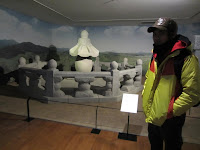After a hearty submarine sandwich and cappuccino at Quiznoz, we went back to the Gyeongbokgung Palace just in time for the 2pm Ceremony of Gate Guard Change. The bright colors of the guards' uniforms were very attractive.
They seem to be having a drill for the tourists to see before the Gwanghwamun gate which took around ten minutes. The guards marched around and followed commands in Korean. While on their rest position, an officer seemed to inspect their uniforms like what they do in military now. After the drill, everyone was given the opportunity to come close to the palace guards and have their photos taken.
The guards who perform at the ceremonies are above the average height of most Korean men nowadays which made us check out their foot gear if they're trying to deceive us. But it's unlikely to happen since they're all wearing traditional foot wear. They tower among the crowd when all were trying to get near them for a photo.
When the ceremony is about to start, the tourists were instructed to enter the gate and were escorted to the audience area. Luckily, we were able to get a place at one of the best areas for a nice view of the ceremony.
The Sumunjang led the entrance of the guards at the strike of the giant bells and drums led by the Chwitagun. Symbolic banners, as colorful as the uniforms of their bearers, waved at the cold winds of winter. If not for our modern winter jackets, we would have thought we've traveled back in time. The sound of the guards' traditional boots echoed around the court as they marched despite the snow and mud on the ground.
The Sumunjang (Commander of the Gate Guard), was the chief military officer during the Joseon Dynasty. He led the gates of the capital such as the Heunginjimun and Sungnyemun as well as the gates of the palaces including Gyeongbokgung, which is the main palace. The Sumunjang was responsible for the security of the monarch and their family who lived in the palace.
The ceremony was established during King Yejong's first year in 1479. With careful studies of the sequence, uniforms, accessories and weapons, Koreans and foreigners are now able to see a part of the ancient tradition of Korea for a deeper understanding of their culture. And this is actually one of the most surprising and most beautiful experience I had in Seoul.
Rank of the Palace Guards:
- Sumunjang - Head of the palace gate guards
- wore golden yellow with red over garment and red headgear
- Gapsa - in charged of guarding the palace gates
- wore white inner garment with red outer
garment and black headgear
- Chabok - the command and control duty soldier
- wore purple robe and black head gear
- Gisu - also guarded the palace gates
- wore aquamarine robe and black headgear
- Sujongjang - in charged of the management of the
- wore all red robe and red headgear
- Jongsagwan - in charged of the management of gate book
- wore red inner garment with blue outer
garment and red headgear
- Jeongbyeong - a regular soldier from the central army
- wore indigo robe and black headgear
- Daejol - guard of the palace gates
- wore green robe and black headgear
- Jeollogun - responsible for the announcement of time
- wore light blue inner garment with black
outer garment and black headgear
- Chwitagun - member of the royal military band
- wore white inner garment with red outer
garment, blue sash and black headgear
Let's see if you can spot each of them in these photos...
 |
| Gate Guard Duty Performance at the Gwanghwamun |
 |
| Gate Guard Duty Performance at the Gwanghwamun |
 |
| Gate Guard Duty Performance at the Gwanghwamun |
 |
| The Sumunjang and Jongsagwan before the platoon |
 |
| Photo- op with the towering palace guards |
 |
| Ceremony of Gate Guard Change brochure and the map of the grounds |
 |
| Entrance of the guards |
 |
| Parade of colors as the huge drum beats |
 |
| The guards marched back near the gate |
 |
| More marching on the slippery and muddy court |
There is a Sumungun costume experience for tourists after the ceremony. You can see a drum on the left side of the gate after you enter.That is the Sumunjangcheong Building where visitors can wear the gate guard's costume and be photographed in it. This is on a first come first served basis which can keep you on queue for several minutes.
---------------------------------------------------------------------------------------------------------------------
How to Get There:
Gyeongbokgung Station (Line3), exit 5
Admission Rates:
Free
Schedule:
Sumunjang Changing Ceremony
10am, 1pm, 3pm (20 minutes per ceremony)
Gwanghwamun Gate Guard Duty Performance
11am, 2pm, 4pm (10 minutes per ceremony)






































